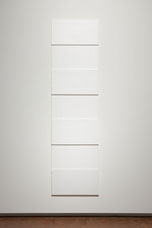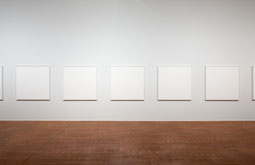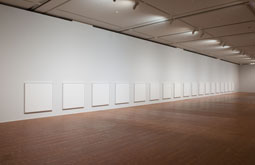 |
Focus features two in-depth reviews each month of fine art, architecture and design exhibitions and events at art museums, galleries and alternative spaces around Japan. The contributors are non-Japanese art critics living in Japan. |
|
|
 |
 |
 |
Whiteout: Tadaaki Kuwayama's Osaka Project
Christopher Stephens |
 |
 |
|
 |
| Untitled, by Tadaaki Kuwayama (1963). Acrylic, Japanese paper on Masonite board, 284.5x76.5x5 cm |
|
Untitled (22 pieces), by Tadaaki Kuwayama (2010). Acrylic, Japanese paper on board, 63.5x44x5.5 cm |
The emergence of the Gutai Art Association in the 1950s and the rise of the Neo-Dada movement in the early '60s seem in retrospect to represent a golden age in Japanese postwar art. But it is interesting to note that at the same time many artists were heading for New York, some never to return. These included Yayoi Kusama in 1957, Ay-O in 1958, Yoko Ono in 1959, and Shusaku Arakawa in 1961. The painter Tadaaki Kuwayama (born in 1932 in Nagoya) also left for New York immediately after graduating from Tokyo University of the Arts in 1958, and is this year celebrating the 50th anniversary of his first solo show.
Influenced by Color Field painters like Mark Rothko and Barnett Newman, Kuwayama set out to erase any trace of the artist's hand or brush and eliminate meaning and emotion from the canvas. This led to the use of neutral colors and inorganic materials like aluminum and Bakelite, and the creation of extremely minimal, meditative work.
Since the 1990s, Kuwayama has focused on "projects" that are made up of a series of works with identical dimensions and colors. The latest of these, White: Osaka Project, was specially designed for the National Museum of Art, Osaka, and occupies a huge, 1,000-square-meter exhibition space, which the artist has divided into three parts.
Counter to his image as a thoroughly contemporary artist, Kuwayama's original training was in Nihonga (Japanese-style painting). And it is to this sensibility that he returns in the Osaka exhibition, as his early works, though made in New York, incorporated pigments and washi (Japanese paper) that he had brought with him from Japan. Thus the inclusion here of one work from 1963 alongside over 50 created between 2008 and the present does not seem at all incongruous.
The installation centers on a 40-meter-long wall, with 18 square works (with sides of 124.5 cm) hanging in a horizontal line 80 cm from the floor on one side, and 18 square works (with sides of 122 cm) hanging in a horizontal line 30 cm from the floor on the other (identical gaps of 50 cm have been left between all of the works on both sides). Though the two spaces would initially seem to be similar, the opposing wall in the first area is only set back six meters, preventing viewers from bringing all of the works into their field of vision at once, and forcing them to focus on a few at a time and to make their way slowly along the wall. Unable to get a firm grip on the display, one is conversely left with a sense of something continuing on into the distance -- something infinite. The opposing wall in the second space is set back nine meters from the works, creating a comparatively spacious area, and emphasizing the extent to which the viewing experience can be controlled and altered by the dimensions of a room. Yet the freedom here does not convey the sense of an endless horizon that one finds on the other side of the wall.
From a distance, the works seem only to be squares of captured whiteness, devoid of pictorial elements or any other distinguishing characteristics. But close up, one sees that they are constructed out of strips of washi tape that have been randomly but skillfully applied at angles to one another, and which overlap and intersect in various ways in each work. The white too looks different, exuding a strangely luminescent quality that approaches a spectrum of color (apparently an effect created by a thin layer of white paint).
Neither written description nor photographic image can communicate the power and beauty of the exhibition. At first, the uniformity of the works pushes the viewer away. Then, the details draw one in and inspire questions about how and why the pieces were made. But ultimately, Kuwayama's Osaka Project returns us to a state of pure white, embodying everything and nothing.
 |
|
 |
| Untitled (18 pieces), by Tadaaki Kuwayama (2010). Acrylic, Japanese paper on honeycomb board, 124.5x124.5x5 cm |
|
Untitled (18 pieces), by Tadaaki Kuwayama (2010-11). Acrylic, Japanese paper on fiber board, 122x122x6 cm
All photos by Kazuo Fukunaga; images courtesy of the National Museum of Art, Osaka
|
|
 |
 |
Christopher Stephens
Christopher Stephens has lived in the Kansai region for close to 25 years. In addition to serving as the editor of the now defunct magazine Kansai Time Out for many years, he has extensive experience as the translator of numerous exhibition catalogues for museums throughout Japan, and art and architecture books such as What's Gutai?, The Architecture of E.G. Asplund: 1885-1940, Salon to Biennial, World Architects 51, Miwa Yanagi: Windswept Women, Tomoko Konoike's Inter-Traveller, and Tadanori Yokoo's Tokyo Y-Junctions. |
|
 |
|